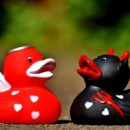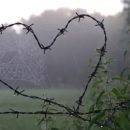Harm Obsessions & Violent Obsessions
Imagine that you’re leaning down to kiss your young daughter goodnight, when BAM! You are jolted by an image of yourself stabbing her to death. Alternatively, picture yourself as a young child who is intensely afraid of playing with your new puppy…not because you’re afraid of dogs but because you are afraid that if you touch it, you might lose control and snap its neck. In either scenario, the most horrifying part is that you’re afraid that you might secretly want to act on these unwanted thoughts. After all, why would the thought keep coming if it didn’t mean something? Violent Obsessions, Harm Obsessions, & Bad Thoughts This is the daily reality for many adults, teens, and children who experience harm obsessions, also known as violent obsessions, a type of OCD symptom that involves unwanted, repetitive violent thoughts, impulses,...
Read MoreOCD Books & OCD Websites
This is a recommended list of OCD books and OCD websites that I consider to be essential reading for individuals with obsessive-compulsive disorder. In addition to my formal training in OCD treatment, these OCD books and websites have had a profound impact on how I conceptualize and treat OCD. This list is not intended to be exhaustive but instead includes only those resources that I have read personally and consider to be the “best of the best.” I will update this list periodically as I come across other “must read” books, websites, and resources for people with OCD. Please note: In order to keep this list streamlined and useful, unfortunately I can’t accept requests for additions to this list. As such, comments have been disabled for this post. Books About OCD Freedom From OCD by Jon Grayson Dr. Jon...
Read MoreOCD & Checking: Part 2 (Mental Checking)
Behavioral Checking (Overt Checking) Many examples of compulsive checking rituals in OCD involve direct inspection of a target stimulus by sight, sound, or feel. Common OCD checking behaviors include relocking doors, visually examining the position of one’s parking brake, or holding one’s hands above stove burners in order to detect warmth. Behavioral checking is often accompanied by the thought, “Did I do it the right way?” These checking behaviors are often referred to as behavioral checks, manual checks, or overt checks. Overt rituals (by definition) are visible behaviors that can be perceived by external observers. However, in some cases, overt rituals may be subtle or purposefully hidden in order to avoid embarrassment. Mental Checking (Covert Checking) In contrast, other compulsive checking rituals can only be perceived by the individual engaging in the behavior. These types of OCD rituals are...
Read MoreChecking & OCD: Part 1 (Checking for Safety)
Compulsive checking often begins innocently enough. One check here, two checks there… But OCD’s greed knows no bounds. What starts out as a simple check “just to make sure” eventually spirals into disabling OCD doubt that can come to predominate innumerable situations and scenarios. Checking behaviors often emerge in situations in which “being irresponsible” might result in catastrophic outcomes, guilt, anxiety, or regret. OCD-related checking is usually driven by a need to obtain absolute certainty that nothing bad will happen. Compulsive checking is typically harder to control in “high stakes” scenarios and in situations in which you perceive that you have personal responsibility for the outcome. Unfortunately, at least some degree of personal responsibility is present in most situations. Moreover, many people with OCD often feel that safety is tenuous or that disasters are lurking just one mistake away....
Read MoreHOCD: Homosexual OCD & Sexual Orientation OCD
Fear of Being Gay (Homosexual OCD / HOCD) Emerging sexuality can be confusing for any teen or young adult, and gay teens face a variety of unique challenges over the course of adolescence. In addition to learning to understand their own sexuality, gay teens must navigate complex situations and pressures that may not be relevant for straight teens. They must also deal with opinionated parents, friends, and others who sometimes hold differing views about sexuality. Anxiety, distress, and confusion are often part of this process. This post is not about the anxiety associated with being gay or with “coming out” but instead discusses homosexual OCD (“HOCD”), an anxiety disorder that affects a small number of individuals. HOCD is not unique to teens but can occur at any age. What is HOCD? Homosexual OCD (“HOCD”) is a specific subtype of...
Read MoreSexual Obsessions in OCD (Obsessive-Compulsive Disorder)
Sexual obsessions in OCD are recurrent unwanted sexual thoughts, such as the fear of being attracted to something unwanted, taboo, or morally “unacceptable” based on one’s particular worldview. Although all forms of OCD can be debilitating, sexual obsessions can be especially confusing and disabling for sufferers because sexual obsessions target one’s fundamental identity as a social being. In addition to anxiety, which characterizes most obsessions, individuals with sexual obsessions often experience extreme guilt, shame, hopelessness, and depression. Individuals with OCD with sexual symptoms often mistakenly consider themselves deviant, disgusting, or evil. Moreover, incorrect assumptions about the true causes of their unwanted sexual thoughts make them less likely to seek treatment or to share their symptoms with others. In my Palm Beach County, South Florida psychological practice, I treat many individuals who have lived with sexual obsessions for many years...
Read More








